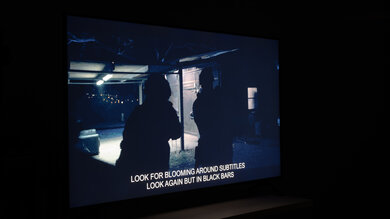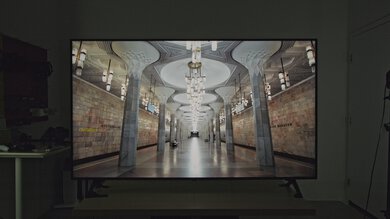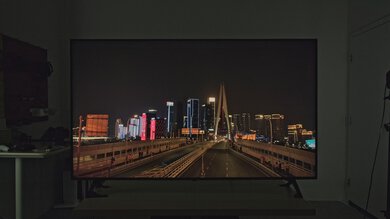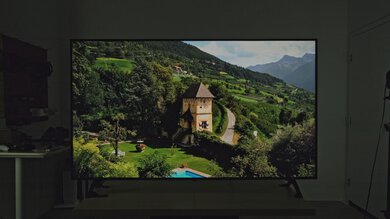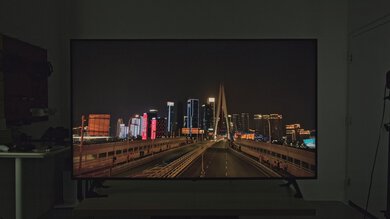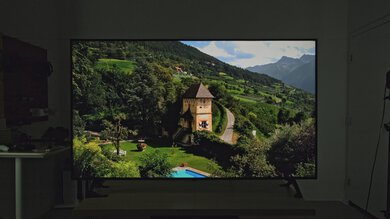The LG UT8000 is a basic entry-level 4k TV released in 2024. It replaces the LG UR8000 and is powered by LG's more recent Gen7 α5 AI Processor and webOS 24, and it has built-in 20W speakers in a 2.0 channel system. It's a very basic TV with no advanced picture processing or gaming features. We bought and tested the 65-inch version, but it's available in a very wide range of sizes, from 43 up to 86 inches, so there's something for just about everyone. It's mainly sold at warehouse outlets like Costco and Sam's Club, as most major retailers in the U.S. don't carry it.
Our Verdict
The LG UT8000 Series is a decent TV overall. It doesn't really excel at any one usage but delivers an okay experience at just about anything. It has low input lag for a responsive gaming experience, but it lacks any advanced gaming features. It's okay for shows or sports during the day, but it's limited by its narrow viewing angle, so you really have to be sitting directly in front of it to enjoy a clear image. Room choice is especially important with this TV, as it's not bright enough to overcome glare in a bright room, but it's not great in a dark room either, as it lacks local dimming to deliver a good dark room experience.
Decent reflection handling.
Great selection of streaming apps.
Colors degrade rapidly when viewed from the sides.
Not bright enough to overcome glare in a bright room.
The LG UT8000 is alright for watching shows during the day. It has good reflection handling but low peak brightness, so it can't overcome glare in a bright room. It also has a narrow viewing angle, so it's best enjoyed from directly in front. On the other hand, the built-in webOS smart interface has a great selection of streaming apps, so you can easily find your favorite content.
Decent reflection handling.
Great selection of streaming apps.
Colors degrade rapidly when viewed from the sides.
Not bright enough to overcome glare in a bright room.
The LG UT8000 is just okay for watching sports in a bright room. It has good reflection handling but low peak brightness, so it just can't overcome glare in a bright room. It also has a very narrow viewing angle. You'll only enjoy a clear image from directly in front of the TV, so it's not a good choice for a wide seating arrangement. There are also distracting uniformity issues. On the other hand, it has a decent response time in bright scenes, so motion is fluid and clear.
Decent reflection handling.
Great selection of streaming apps.
Colors degrade rapidly when viewed from the sides.
Not bright enough to overcome glare in a bright room.
The LG UT8000 is decent for gaming. It has low input lag, ensuring a smooth and responsive gaming experience, and there's no impact on picture quality by switching to the low-latency picture mode. The pixel response time is decent overall, although there's some noticeable inverse ghosting in shadow details. On the other hand, it's very light on gaming features, with no variable refresh rate support and a limited 60Hz refresh rate.
Low input lag.
Decent reflection handling.
Colors degrade rapidly when viewed from the sides.
60Hz refresh rate and limited gaming features.
Not bright enough to overcome glare in a bright room.
The LG UT8000 is decent for watching movies in a dark room. It has excellent SDR accuracy out of the box, so you don't have to worry about getting it calibrated to get an accurate image. Its picture quality in a dark room is a bit limited, though, as it lacks a local dimming feature to deliver deep blacks. It supports HDR10, but HDR adds nearly nothing, as it's not bright enough for bright highlights to stand out, and it can't display a wide color gamut.
High native contrast for deep blacks.
Great black uniformity.
Great selection of streaming apps.
No local dimming feature to improve contrast.
Low peak brightness in HDR.
The LG UT8000 delivers a decent overall HDR gaming experience. It has low input lag for a responsive gaming experience, and it has a decent pixel response time, so motion is fairly clear and responsive. It's light on gaming features, though, with no variable refresh rate support and a limited 60Hz refresh rate. HDR also adds very little to your gaming experience on this TV, as it's not bright enough to bring out bright highlights in games, and HDR looks flat and dull.
High native contrast for deep blacks.
Great black uniformity.
Low input lag.
No local dimming feature to improve contrast.
Colors degrade rapidly when viewed from the sides.
Low peak brightness in HDR.
60Hz refresh rate and limited gaming features.
The LG UT8000 is a decent choice for use as a PC monitor. It supports chroma 4:4:4, which is essential for clear text from a PC, and it has low input lag for a responsive desktop experience. It also has a decent response time, but there's noticeable inverse ghosting in shadow areas. Room choice is important, though, as it's not bright enough to overcome glare in a bright room. It also has a narrow viewing angle, so the sides of the screen appear non-uniform if you're sitting too close to the screen.
Low input lag.
Chroma 4:4:4 is displayed properly for clear text from a PC.
Decent reflection handling.
Colors degrade rapidly when viewed from the sides.
60Hz refresh rate and limited gaming features.
Not bright enough to overcome glare in a bright room.
Check Price
Differences Between Sizes And Variants
We bought and tested the 65-inch LG UT8000 (65UT8000AUA), which is also called the LG UT80 for short. It's also available in 43, 50, 55, 70, 75, and 86-inch sizes. The last three letters in the model number (AUA in this case) vary between retailers and individual regions, but there's no difference in performance.
Internationally, this model is available in a few different variants. Most major European markets carry the LG UT81 (UT81006LA) instead, which performs the same but has a center-mounted stand. There's also a variant known as the LG UT8050 which is sold in a few Asian countries and Australia. It appears to be the exact same TV, but we don't know for sure.
| Size | US Model | Refresh Rate | VRR | Processor | VESA Mounting Pattern |
|---|---|---|---|---|---|
| 43" | 43UT8000AUA | 60Hz | No | α5 AI Processor 4k Gen7 | 200 x 200 |
| 50" | 50UT8000AUA | 60Hz | No | α5 AI Processor 4k Gen7 | 200 x 200 |
| 55" | 55UT8000AUA | 60Hz | No | α5 AI Processor 4k Gen7 | 300 x 300 |
| 65" | 65UT8000AUA | 60Hz | No | α5 AI Processor 4k Gen7 | 300 x 300 |
| 70" | 70UT8000AUA | 60Hz | No | α5 AI Processor 4k Gen7 | 400 x 400 |
| 75" | 75UT8000AUA | 60Hz | No | α5 AI Processor 4k Gen7 | 400 x 400 |
| 86" | 86UT8000AUA | 60Hz | No | α5 AI Processor 4k Gen7 | 600 x 400 |
Our unit was manufactured in May 2024, as seen on the TV's label.
Popular TV Comparisons
The LG UT8000 is a very basic TV with just okay picture quality and very few additional features, and it's not worth buying. It's an okay choice if you just want a brand-name TV and don't care much about picture quality, but budget picks from brands like Hisense and TCL offer far more bang for your buck.
For more options, check out our recommendations for the best budget TVs, the best smart TVs, and the best 4k TVs.
There's almost no difference between the LG UT8000 and the model it replaces, the LG UR8000. Although the UT8000 uses a newer image processor, it actually performs a bit worse overall, and the new model isn't as good at smoothing out low-quality streaming content.
The LG UT75 and the LG UT8000 are similar overall, but the UT80 is a bit better for most people. The UT80 has a much higher contrast ratio, so it's a better choice for dim or dark rooms, as blacks are deeper and more uniform. On the other hand, if you never watch TV in a dark room, the UT75 might be a better choice as it has a wider viewing angle, so you'll see a more consistent image if you're watching at a bit of an angle.
The Hisense QD65NF and the LG UT8000 are very similar overall; they trade blows in a few ways that might make one better than the other, depending on your preferences. If you care more about an accurate image, the LG is the way to go, as it's much more accurate out of the box. If you prefer a punchier image, though, the Hisense is the better choice, as it's brighter and has a much wider color gamut. This comes at the expense of accuracy, though, as the Hisense is visibly off in most content.
The Samsung DU7200 and the LG UT8000 are closely matched, and you should buy the cheapest one you can find. Still, the two have minor differences; the Samsung is a bit brighter and more colorful, but the LG is generally more accurate out of the box. The Samsung's viewing angle is a bit wider (although both are narrow), but the LG's reflection handling is a bit better. The LG's image processing is a bit better overall, but the Samsung offers more to gamers due to its VRR support and faster response time.
Test Results

This TV uses a pair of V-shaped feet, which support the TV well. The stand lifts the display about 3.3 inches above the table, so you can easily place a soundbar in front of the TV without blocking the screen. There's no alternate position for the feet, so you can't place them closer together if you have a narrow table. The feet support the TV well, but it wobbles fairly easily.
Footprint of the 65-inch model: 47.4" x 10.6".
The back of the TV is very plain. The inputs are recessed into the back panel, making them difficult to reach when the TV is wall-mounted. One of the HDMI ports faces out the back of the TV, so you'll likely need an HDMI angle adapter if you plan on wall-mounting it. There are clips just above each foot for very basic cable management.
The LG UT8000 has passable native contrast. Without a local dimming feature, this TV relies on its native contrast in dark scenes. The contrast ratio isn't high enough to preserve deep blacks in scenes with any amount of brightness to them. In deeper scenes with no bright highlights, it looks better, but blacks still aren't very deep.
This TV doesn't have a local dimming feature, so it can't adjust the backlight of individual zones to brighten up highlights without impacting the rest of the image. But this means that there's no distracting flicker or brightness changes as bright highlights move between zones.
Unfortunately, this TV has sub-par peak brightness in HDR. It's bright enough to deliver most scenes at the brightness level the content creator intended, but with no local dimming and low peak brightness highlights and bright areas of the scene don't stand out at all.
These measurements are after calibrating the HDR white point with the following settings:
- Picture Mode: Cinema
- Panel Brightness: 100
- Adjust Contrast: 100
- Color Temperature: Warm 50
- Dynamic Tone Mapping: Off
We tested the TV with Dynamic Tone Mapping set to 'Off.' When it's enabled, the results are notably worse, with the image looking dim and washed out in real scenes, so we recommend keeping it disabled for HDR content. For reference, you can see the results with Dynamic Tone Mapping enabled below:
- Hallway Lights: 212 cd/m²
- Yellow Skyscraper: 199 cd/m²
- Landscape Pool: 122 cd/m²
Switching to the 'Game Optimizer' Picture Mode causes no noticeable change to the TV's peak brightness. Overall peak brightness is still too low for an impactful HDR gaming experience.
These measurements are after calibrating the HDR white point with the following settings:
- Game Optimizer: On
- Picture Mode: Game Optimizer
- Panel Brightness: 100
- Adjust Contrast: 100
- Color Depth: 50
- Color Temperature: Warm 50
- Dynamic Tone Mapping: HGiG
The PQ EOTF tracking on this TV is fantastic. Even though it's not very bright overall, most HDR content is displayed close to the brightness levels the content creator intended. Near-blacks are raised due to the lack of local dimming, and bright highlights aren't bright at all as the TV's brightness starts rolling off very early.
The peak brightness in SDR is mediocre. It's simply not bright enough to overcome glare in a bright room, so if you have lots of windows or bright lights, the screen is hard to see.
These measurements are after calibration with the following settings:
- Picture Mode: Expert (Dark Space, night)
- Panel Brightness: 100
- Color Tone: Warm 50
- Gamma (Adjust Brightness): 2.2
The LG UT8000 has a decent color gamut in HDR. It has good coverage of the widely-used DCI-P3 color space, but coverage of the wider Rec.2020 color space is disappointing, and it can't display a wide color gamut. The tone mapping is also bad throughout when sent a 75% stimulus, which corresponds to content mastered at 1,000 nits, so most HDR content is inaccurate. In dimmer scenes, the TV performs much better:
Sadly, this TV has sub-par color volume. Due to its limited color gamut and low peak brightness, it can't display a wide range of colors at any luminance level, and saturated colors are dim.
Despite its other flaws, the LG UT8000 has surprisingly good accuracy in SDR before calibration. Darker shades of gray are slightly off, but it's not really noticeable. Dark blues are a bit worse, and gamma is way off, so most SDR content is brighter than it should be.
This TV is nearly perfect in SDR after a quick calibration. Its calibration system is easy to use but a bit sensitive. After calibration near-blacks are still a bit over-brightened, but it's not noticeable.
Make sure to check out the full calibration settings we used.
Unfortunately, the LG UT8000 has poor off-angle viewing. The image degrades rapidly as you move off-center, as colors wash out and fade, and black levels rise rapidly. This makes it a poor choice for a wide seating arrangement, as anyone sitting to the side won't enjoy a clear picture.
The TV has good reflection handling, but there are a few noticeable issues. Any bright source of light reflected on the screen has a noticeable rainbow smear. The coating absorbs some light, reducing its intensity, but since this TV can't get very bright overall, it's not suited for a bright room.
The LG UT80 has decent HDR gradient handling. There's noticeable banding in almost all shades, but it's most noticeable in dark shades of gray.
This TV uses a BGR subpixel layout, which doesn't impact the image quality, but it makes text look blurry in some applications that don't support the BGR layout, which is important if you want to use it as a PC monitor. You can read more about our monitor picture quality tests here.
Its spectral power distribution shows that the panel technology doesn't use Quantum Dot technology or KSF phosphors.
The LG UT8000 has a decent response time overall. Brighter scenes look the best, as the TV has a quick response time to and from most bright colors. Dark scenes are worse, though, as it's very slow to transition from an 'off' state to a dark shade, so shadow details are blurry and there's significant overshoot, causing inverse ghosting.
Unfortunately, this TV uses pulse width modulation (PWM) to dim the backlight, and it flickers at a low frequency, causing noticeable image duplication. At max brightness, the flicker isn't nearly as noticeable, as instead of a full square wave with equal on/off cycles, the brightness only dips down briefly at 120Hz.
This TV doesn't have an optional backlight strobing feature, also known as BFI. Instead, the backlight always flickers at 120Hz, which helps reduce persistence blur but introduces severe image duplication below max brightness.
Thanks to this TV's relatively slow response time, there's very little stutter when watching low frame rate content.
This TV removes judder from most sources without introducing motion interpolation. 24p sources work perfectly with the Real Cinema feature enabled. 60p/i sources, on the other hand, are only judder-free if you enable motion interpolation and set De-Judder to '10'.
Unfortunately, all sizes of this TV are limited to 60Hz and don't support VRR, so you'll see more screen tearing when playing games that can't maintain 60fps. Previous generations of this lineup had a more powerful 86-inch version, which had a 120Hz panel, but not this year, according to LG's specs.
This TV has superbly low input lag, ensuring a very responsive desktop experience if using this TV as a monitor or very responsive inputs when gaming.
The TV supports most common resolutions but only at a 60Hz refresh rate. It displays chroma 4:4:4 signals properly at all supported resolutions, essential for clear text from a desktop PC.
It's limited to HDMI 2.0 bandwidth on all three of its HDMI ports, and it doesn't support HDR10+ or Dolby Vision, so you're limited to HDR10.
Unfortunately, this TV doesn't support DTS audio formats, which are often used for the main audio track on physical media.
The LG UT8000 has a decent frequency response. It gets very loud and has a well-balanced sound profile at moderate listening levels. Like all TVs, though, there's very little bass response, with no boom or thump in deep bass.
The distortion performance is decent. There's very little audible distortion at moderate listening levels, but it increases noticeable at max volume.
The LG UT8000 launches with webOS 24, which features a new AI-powered assistant built-in to the TV and built-in Google Chromecast support. This TV is part of LG's Re:New program, so the webOS interface will continue to receive platform updates for the next five years.
Unfortunately, although it supports most of the same features as the higher-end LG TVs, the slower processor on this model leads to a less-than-stellar experience with webOS. Audio commands often don't work at all, and the menu is noticeably slower and unresponsive at times.
Unfortunately, like almost all TVs on the market, there are ads throughout the smart interface, and you can't fully disable them. You can limit ad tracking and remove ads from the home screen using the 'Home Promotion' and 'Content Recommendation' settings in the 'Home Settings' menu, but there's no way to remove ads from the apps page.









